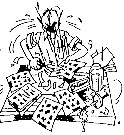PROJECT BACKBOARD
A major part of your science
fair project is the backboard because it communicates your ideas to others.
The main purpose of the backboard is to state what you did and how you did
it. the backboard should be clearly lettered and easy to read from
a couple of feet away. Always print. Type it if you can.
Use plain paper, do not put notebook paper up on the backboard. Any
models, log books, and journals will go in the space in front of your backboard.
The backboard should look interesting. You can
be a little creative in your title and can use illustrations. The
backboard itself should be of good construction. The store bought
foam or cardboard boards are what many students use. You may choose
to build your own backboard, if you have a particularly unique project.
If you do build your own backboard, the maximum dimensions for a backboard
are: 4 feet wide, 30 inches deep, and 9 feet high from the floor including
table if used.
Your backboard should contain:
A. TITLE - short, explanatory, clear, and easy to read.
B. ABSTRACT - summary of the research, experiment, and main references.
Your abstract on the backboard should have the title and the written
summary. You can also put your name and your school in the abstract.
PLACE ABSTRACT IN LOWER LEFT CORNER
C. PURPOSE (OR QUESTION) - clear statement of what you are trying
to find out. The purpose can be stated in the form of a question.
D. HYPOTHESIS - your prediction of what the outcome of your experiment
will be. Your hypothesis should be made before you actually do you
experiment(s). Your hypothesis should be based upon your own previous
experience, observations, or thoughts of others, and the literary research
you did in choosing the topic, variables, and controls.
E. PROCEDURE - the step by step plan you used in doing your experiment.
Enough information should be given so that someone else could follow these
directions and do the same experiment.
F. RESULTS - your description of what happened. You should
have a written description and use diagrams, charts, graphs, and photographs
to present your results.
G. CONCLUSION - Explain your results in relation to your purpose
and hypothesis. Restate your purpose/hypothesis and state if it was
correct. Explain why it was or why it was not. Try to say what
you would do next and what you think would happen then.
H. PHOTOS - All photos/images must be cited (i.e. Photo taken by...or Image taken from...), no offensive or inappropriate images (as decided by the SRC).
DO NOT INCLUDE: Food, live or dead organisms,
dangerous chemicals, exposed wires or open flames.
